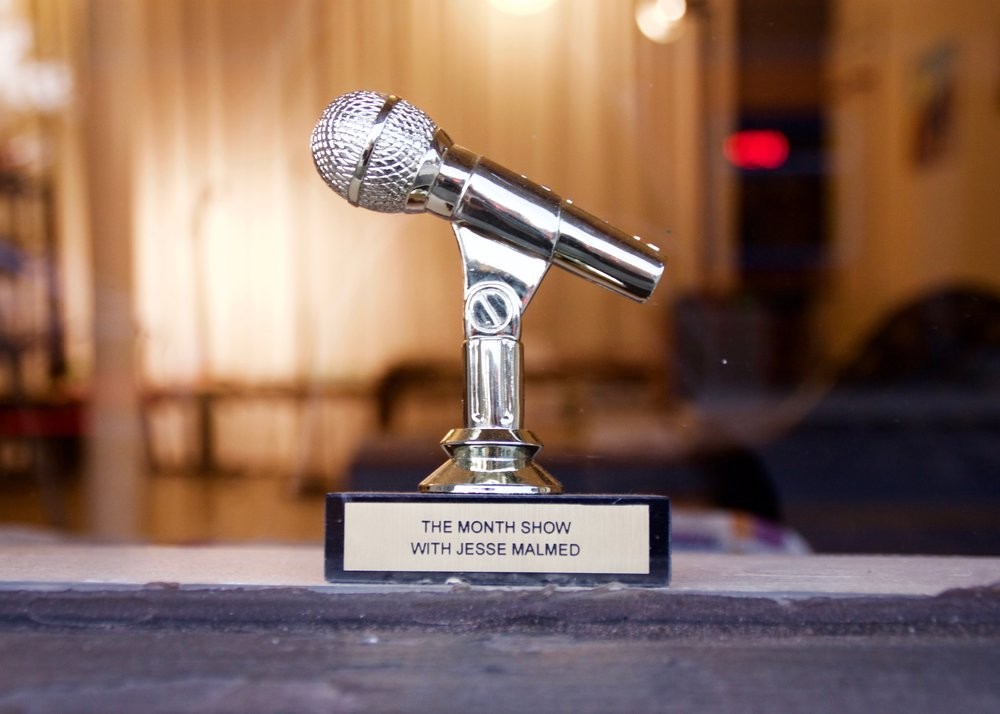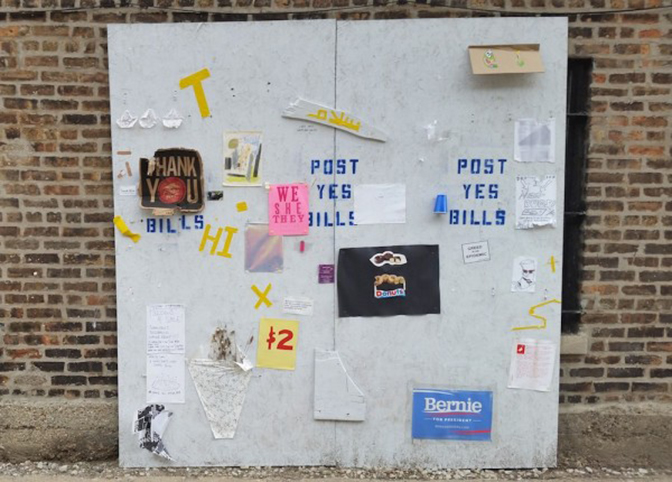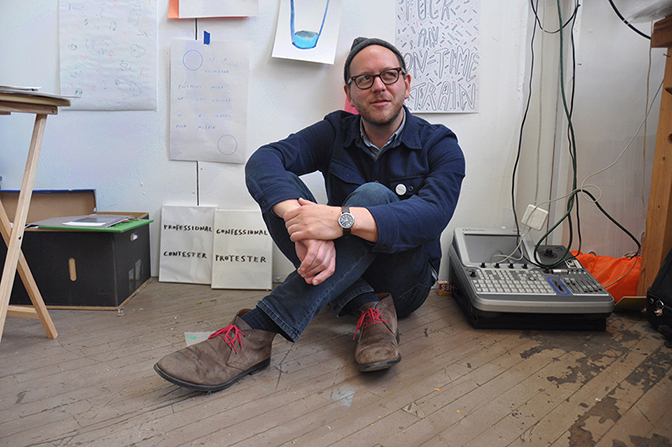Most comfortable in the public domain (real or virtual), Jesse Malmed investigates the intersection of language, sonic systems, and his contemporary milieu via an array of continually probing installations, performances and videos. Malmed’s affable wry wit and unconventional delivery frequently brings pause in a time where discursive display has become a standard. This week The COMP Magazine caught up with Malmed at his West Fulton Street studio to discuss his circuitous examinations, technical strategies, role as an educator and what upcoming efforts are on the slate.

Jesse Malmed, THE MONTH SHOW, 2016
Can we start with a little background? You grew up in the southwest (New Mexico), studied out east at Bard, and landed in Chicago. So, can you offer any insight regarding your early experiences and the impact they may have had on your current art practice?
There’s also a detour on the west coast between Bard and Chicago (I lived in both San Francisco and Portland) as well as several trips internationally and within the country as well as a long string of summers with family in western Canada, much of it spent selling junk at the flea market with my grandfather, Poppa Clown — as long as we’re talking about places. All of these experiences impacted who I am and what kind of work I make — how could they not? My parents met in Kabul in 1971, two wild-haired freaks out looking for adventure and enlightenment, sure in their bones that there was a lot of world out there. They spent the next decade-plus traveling, mostly in India. Eventually they thought to return to North America. They landed in Santa Fe (full name: La Villa Real de la Santa Fe de San Francisco de Asís, ahem) on the eve of Zozobra — our annual celebration in which the town gets together and burns a 40 foot puppet who represents gloom — and knew they’d found their spot. Broke but eager, they found their way to a one room adobe on a dirt road, started stringing beads and, as they say, yada yada yada, now I’m responding to these questions on a train headed from Joliet to Chicago.
Lets talk about language. Specifically, your interest in this subject. Can you discuss your interest in the sonic and visual intersection of this item? Why does this pique your interest?
We are never not languaging. Language, they say, is the house that humans built. We live inside of it and it impacts our every perception of the world. Or, at least, it does mine. As such, I believe we can remake our world through a reconsideration of language. This means considering that language is more than an instrument of communication. Each word bears with it a distinct social/political/historical legacy. Each word also exists simultaneously as a sound and an image, each of which we usually feel more comfortable reshaping than we sometimes do language. I’m interested in what happens when poems and jokes are confused for each other, when we try to discern semantic meaning from the sounds birds and trains make to us, what our handwriting looks like in another language.
I’d like to discuss your approach to video. I see a number of technical strategies occurring (appropriation, use of text only, standard filming). Can you discuss your process? What drives a specific work or any larger inquiry you are currently pursuing?
Most of my video works bounce between images, texts, sounds and ideas that I’ve shot and that I’ve sought. They borrow from different traditions, but are heavily influenced by thinking through the codes of conventional, counter-cultural and avant-garde film, video and television. I’m hoping to craft works that provide an atmosphere that’s beguiling but seductive, that keep watchers on their toes, like a dérive with an ever-shifting driver. My interest in moving image work is heavily steeped in the last half-century of experimental cinema, which, at its core demands that cinema can do more than just tell the same old stories in the same old ways, that it can be personal, political, material, non-narrative, essayistic, poetic, musical, mystical, structural, etc. Novels are great, sure, but so is poetry, so are essays, so are diaries, so are postcards from a loved one, so are protest signs.
Each of the works is teeming with ideas and I’m more interested in a flurry or constellation of meanings than a strict about-ness. I’m drawn to hybridic works that take dynamics seriously, flitting between soft and loud, fast and slow, textual and textural.
In addition to your art practice, you are an educator. You teach a wide range of young people. Are there any regular items you frequently share? Do you see this activity informing your ongoing investigations?
Teaching is great. I mean, not in terms of money or stature or stability, but in terms of many of things I care most about: talking about, reading about, writing about, making and facilitating art. This semester I’m at a kindergarten, high school and two colleges. Each class is really different, obviously, but share a number of similarities. Art is a way to give ideas and experiences new forms, which enables us to reconsider and more deeply engage with the world, other people and our own lives. I believe our critical, emotional, intellectual and political acuities are honed more exposure, conversation surrounding and understanding of art. There was a half-erased white board in a high school I passed by yesterday that made its motivational point with its letter shapes and the gaping space around them: “education is / -mate form of optimis “.
What do you value most in your art practice?
The chance to play with ideas and do so in new and interesting ways with new and interesting people.
What’s the plan for the remainder of 2017? Do you have any specific works or exhibitions in the works?
Yeah! I have a screening at the MCA on April 11th and am opening an exhibition at Produce Model Gallery with Alex Bradley Cohen and Alberto Aguilar April 22nd. I have some works showing in screenings and festivals soon as well some cameos in big group shows in the next few months (and co-starring roles in some smaller ones). I’ll be working at the ACRE residency in southwestern Wisconsin again this summer as a Programming Coordinator / Visiting Artist Liaison, attending a new pilot residency in Vermont this summer and working toward curating some shows, including Outside Jokes, a series of outdoor sculptures designed to problematize the notion of site-specificity and make people laugh at DEMO Projects in Springfield, IL. Western Pole is always up.

Jesse Malmed, POST YES BILLS, 2016
For additional information on the aesthetic practice of Jesse Malmed, please visit:
Jesse Malmed – http://jessemalmed.net/
Trunk Show – http://trunkshowtrunkshow.tumblr.com/
Western Pole – http://westernpole.tumblr.com/

Jesse Malmed at his Fulton Street Studio, Chicago, IL 2017 by Chester Alamo-Costello
Artist interview by Chester Alamo-Costello


